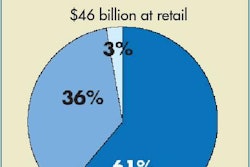.png?auto=format%2Ccompress&q=70&w=400)
Innovation and product development have fueled industry growth for several years now, to the point that you might think we've seen it all in terms of truly new petfood products. Conventional wisdom also says that much of this innovation happens in smaller companies.
With the launch of its WholeMeals line of dog food ( www.wholemeals.com ) in US pet specialty stores, Mars Inc. is challenging both assumptions.
How dogs want to eat
Tiffany Bierer, PhD, director of health sciences and nutrition for Mars Petcare US, describes the new product as revolutionary. "We're trying to give something more in tune with a dog's natural feeding behaviors - something that gives dogs a lot more enjoyment but is also much healthier for them."
Bierer adds that the traditional way of feeding dogs - giving kibble in a bowl - may not be the way they want to eat. "We've done a lot of work with behaviorists. At the Center for Nonverbal Studies in Spokane, Washington, USA, they study body movements, facial movements and what those really mean. They helped us compare how dogs eat regular dry kibble vs. WholeMeals," she says.
Measuring 30 body language cues on videotapes of the dogs eating, the studies showed a drastic difference, Bierer says. "When you feed dry food, normally the dog doesn't look up, it will just lean over and inhale a big bowl of food and that's it. There's not much interaction with the food.
"With WholeMeals, you see dogs pick it up," she continues. "They carry it around, they can decide where they eat, they can decide how fast they eat. It amazes me every time I watch dogs play with the product. They toss it in the air, they play around with it, they show it off to their family." Mars says the mean feeding time with WholeMeals is 300-400% longer than that with kibble.
Complete and balanced
Though WholeMeals is shaped like a treat or chew, it's designed to be a complete and balanced premium diet. Besides high-quality protein, Mars says, the product has natural glucosamine and chondroitin to support joint health, omega-6 fatty acids for coat and skin health and antioxidants (vitamins E and C) to boost the immune system.
WholeMeals comes in four sizes - for toy, small, medium or large dogs - and 24 pieces to a bag, providing six or more days' worth of food depending on the size. For example, a large dog would need to eat two of the large WholeMeals a day if that's the only food provided. The retail price ranges from US$9.99 a bag for the toy size to US$24.99 for the large. (A trial bag for each size is also available.)
The packaging and promotional materials explain the number of WholeMeals to feed. "Our feeding guidelines tell exactly what the equivalency is: This WholeMeals equals this much dry food equals this much canned food," Bierer says. "We're trying to drive home the point that this is meant to be fed in place of a dog's normal food. One of the nice things, too, is because it prolongs the eating experience, it makes the dog chew a lot more and get more satisfaction vs. inhaling a bunch of food and still being hungry."
For those pearly whites
Bierer says the product also provides dental benefits. "We based the four sizes on some biometric work looking at bite force (how hard dogs can bite down) and how much they can open their mouths. We've designed the product to make sure it can fit back in the dogs' mouths, so for example, the toy size is specifically for toy dogs and their tiny little mouths."
The product is designed to brush over a dog's teeth as it chews. Mars has conducted oral care studies showing WholeMeals reduces plaque accumulation by 43% and tartar by 83%, compared with traditional dry dog food. "As a nutritionist, the big thing for me is gum health," Bierer adds. "The product causes a significant reduction in gingivitis, too." (See Figure 1.)
A real revolution?
Bierer is a key member of a team - including experts at the Waltham Centre for Pet Nutrition in Melton Mobray, UK - who have been developing WholeMeals since 2001. She says she's excited to see it finally on the market. "It means the world to me to make something that not only makes a dog healthier, but also a lot happier. I hope it's going to be a real revolution in the way people feed their dogs."






.png?auto=format%2Ccompress&fit=crop&h=167&q=70&w=250)










